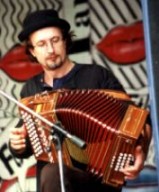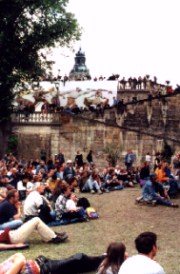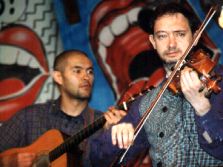FolkWorld Live Review 8/2000:
Tanz & Folk Festival Rudolstadt
The place to be...
By Anja Beinroth
 There are two things I love about the annual Rudolstadt festival. The
first is the atmosphere - seeing a whole town be taken over by the
festival and swept up in its spirit, "folk fever" as the
locals refer to it. Diving into the crowds, the great mix of ordinary
people and extraordinary characters of all ages who have come from all
over Germany and beyond, the friendly, peaceful way people interact.
Particularly this year, only days after nine festival goers had been
crushed to death in Roskilde, the difference between a rock festival
and the Rudolstadt atmosphere was extremely noticeable. The vast
majority of the many stages manage without any security barriers, and
yet you just couldn't imagine something like that happening in
Rudolstadt.
There are two things I love about the annual Rudolstadt festival. The
first is the atmosphere - seeing a whole town be taken over by the
festival and swept up in its spirit, "folk fever" as the
locals refer to it. Diving into the crowds, the great mix of ordinary
people and extraordinary characters of all ages who have come from all
over Germany and beyond, the friendly, peaceful way people interact.
Particularly this year, only days after nine festival goers had been
crushed to death in Roskilde, the difference between a rock festival
and the Rudolstadt atmosphere was extremely noticeable. The vast
majority of the many stages manage without any security barriers, and
yet you just couldn't imagine something like that happening in
Rudolstadt.
The other thing that makes it a very special event in
my view is the way it exposes people to musical experiences they would
not have come across anywhere else. There's always a rich choice of
music to be experienced, some of which has rarely or never made it to
Germany before, some of which you just wouldn't have made the effort
to go and see under normal circumstances, but which you find yourself
really enjoying.
 Among this year's more surreal experiences was
the concert by extravagant Japanese band Cicala Mvta - with the
wildest, craziest cellist I've ever seen, Hiromichi Sakamoto. As a
special guest, they had brought along the chindon drummer from Soul
Flower Mononoke Summit. In the afternoon before the concert, she and
Cicala Mvta's leader, clarinetist Wataru Okuma (with a little help
from knowledgeable and enthusiastic interpreter Paul Fisher of The Far Side) gave a
fascinating presentation on, and demonstration of, the Japanese
chindon tradition which evolved at the turn of the last century,
peaked in the 1920s and again after the Second World War, and largely
died out in the 1960s, but has recently seen a bit of a revival.
Among this year's more surreal experiences was
the concert by extravagant Japanese band Cicala Mvta - with the
wildest, craziest cellist I've ever seen, Hiromichi Sakamoto. As a
special guest, they had brought along the chindon drummer from Soul
Flower Mononoke Summit. In the afternoon before the concert, she and
Cicala Mvta's leader, clarinetist Wataru Okuma (with a little help
from knowledgeable and enthusiastic interpreter Paul Fisher of The Far Side) gave a
fascinating presentation on, and demonstration of, the Japanese
chindon tradition which evolved at the turn of the last century,
peaked in the 1920s and again after the Second World War, and largely
died out in the 1960s, but has recently seen a bit of a revival.
The chindon is a drum set made up of two drums and a small gong which
are carried around on a shoulder-mounted wooden frame, typically
accompanied by a (very large) "goros" drum, clarinet or
saxophone, and a flag or banner bearer. The original purpose of these
marching bands was to advertise newly-opened restaurants or shops by
walking the streets in colourful costumes, playing adaptations of
popular songs and grabbing people's attention by means of noise and
spectacle. Not something you witness every day, certainly not in
Germany.
The chindon presentation was one of the many events in
the festivals newest venue, added this year, the multi-screen
CinePlaza cinema. It offered welcome refuge from the uncertain
weather, and a chance to meet and question some of the performers. It
also offered the opportunity to watch a selection of rarely-to-be-seen
films with a folk/world music connection (documentaries, concert
movies, films with Goran Bregovic soundtracks) - a good idea, but time
seemed too precious to take advantage of it.
Probably the most popular of the CinePlaza events was the chance to meet some of the
representatives of this year's featured country, England. In an
extended question-and-answer session with "unplugged"
musical interludes, Sin É and Waterson:Carthy presented their
views on the past and future of (English) folk music. Sadly,
Waterson:Carthy's main concert in the castle grounds on Friday was
ruined for me by a spectacular downpour which no ordinary raincoat
could cope with, so I had to leave and find shelter in one of the
indoor venues, where Moanalani Beamer was busy demonstrating Hawaiian
hula dancing. Fortunately the rain stopped in time for North Italian
B.E.V.'s wonderful concert, which won them many new fans. A second
attempt to catch Waterson:Carthy when they played in Rudolstadt's
theatre on Sunday morning also failed miserably due to overwhelming
demand - even when the theatre was filled to capacity, the queue was
still long enough to have filled it again. So
much for that...
 Apart from Sin É and Waterson:Carthy, England was represented
by the Hammersmith Morris Men, Paul Millns, Kathryn Williams, The
Committee Band (who coped remarkably well with the overcrowded
conditions in the dance tent) and the Bollywood Brass Band
(complete with drummers from the Dhol Foundation), who proved so
popular with the audience everywhere they appeared that they
hopelessly sold out of CDs, leaving many would-be purchasers
disappointed. I particularly enjoyed their unamplified performance on
one of the small stages in the town centre's main pedestrian road,
where they caused a massive "traffic" jam and even attracted
a handful of local residents to their windows overlooking the
street.
Apart from Sin É and Waterson:Carthy, England was represented
by the Hammersmith Morris Men, Paul Millns, Kathryn Williams, The
Committee Band (who coped remarkably well with the overcrowded
conditions in the dance tent) and the Bollywood Brass Band
(complete with drummers from the Dhol Foundation), who proved so
popular with the audience everywhere they appeared that they
hopelessly sold out of CDs, leaving many would-be purchasers
disappointed. I particularly enjoyed their unamplified performance on
one of the small stages in the town centre's main pedestrian road,
where they caused a massive "traffic" jam and even attracted
a handful of local residents to their windows overlooking the
street.
Another first-time visitor to Germany was Zimbabwean
superstar Oliver Mtukutzi, who gave an excellent concert on the main
Heinepark stage on Saturday night and - to many people's
disappointment - sadly wasn't allowed back for any encores. There was
simply still too much else to get through.
As ever, the closing
concert on Sunday evening, which consists of multiple short
performances and a longer one to close the festival, was a chance to
see favourite performers again as well as to catch some of what I'd
missed before (even Waterson:Carthy, but without melodeon-player Saul
Rose by then). By the time Huracán de Fuego took over for the
final hour of music and dance, it seemed hard to believe that it was
already all over for another year. Time to start looking forward to
the next one!
There is another Review of the Rudolstadt Festival in this issue.
Photo Credit: Photos by The Mollis, all taken at Tanz & Folk Festival Rudolstadt 2000:
(1) and (3) BEV, (2) impression at the castle
Further infos available at: Hompepage of Rudolstadt town, with a page for the festival
To the content of FolkWorld Articles, Live Reviews & Columns
To the content of FolkWorld online magazine Nr. 15
© The Mollis - Editors of FolkWorld; Published 8/2000
All material published in FolkWorld is © The Author via FolkWorld. Storage for private use is allowed and welcome. Reviews and extracts of up to 200 words may be freely quoted and reproduced, if source and author are acknowledged. For any other reproduction please ask the Editors for permission.
FolkWorld - Home of European Music

Layout & Idea of FolkWorld © The Mollis - Editors of FolkWorld
 There are two things I love about the annual Rudolstadt festival. The
first is the atmosphere - seeing a whole town be taken over by the
festival and swept up in its spirit, "folk fever" as the
locals refer to it. Diving into the crowds, the great mix of ordinary
people and extraordinary characters of all ages who have come from all
over Germany and beyond, the friendly, peaceful way people interact.
Particularly this year, only days after nine festival goers had been
crushed to death in Roskilde, the difference between a rock festival
and the Rudolstadt atmosphere was extremely noticeable. The vast
majority of the many stages manage without any security barriers, and
yet you just couldn't imagine something like that happening in
Rudolstadt.
There are two things I love about the annual Rudolstadt festival. The
first is the atmosphere - seeing a whole town be taken over by the
festival and swept up in its spirit, "folk fever" as the
locals refer to it. Diving into the crowds, the great mix of ordinary
people and extraordinary characters of all ages who have come from all
over Germany and beyond, the friendly, peaceful way people interact.
Particularly this year, only days after nine festival goers had been
crushed to death in Roskilde, the difference between a rock festival
and the Rudolstadt atmosphere was extremely noticeable. The vast
majority of the many stages manage without any security barriers, and
yet you just couldn't imagine something like that happening in
Rudolstadt.
 Among this year's more surreal experiences was
the concert by extravagant Japanese band Cicala Mvta - with the
wildest, craziest cellist I've ever seen, Hiromichi Sakamoto. As a
special guest, they had brought along the chindon drummer from Soul
Flower Mononoke Summit. In the afternoon before the concert, she and
Cicala Mvta's leader, clarinetist Wataru Okuma (with a little help
from knowledgeable and enthusiastic interpreter Paul Fisher of
Among this year's more surreal experiences was
the concert by extravagant Japanese band Cicala Mvta - with the
wildest, craziest cellist I've ever seen, Hiromichi Sakamoto. As a
special guest, they had brought along the chindon drummer from Soul
Flower Mononoke Summit. In the afternoon before the concert, she and
Cicala Mvta's leader, clarinetist Wataru Okuma (with a little help
from knowledgeable and enthusiastic interpreter Paul Fisher of  Apart from Sin É and Waterson:Carthy, England was represented
by the Hammersmith Morris Men, Paul Millns, Kathryn Williams,
Apart from Sin É and Waterson:Carthy, England was represented
by the Hammersmith Morris Men, Paul Millns, Kathryn Williams, 